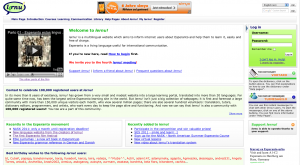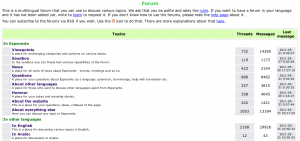Esperanto learning site, lernu! reaches 100,000 users Posted by Chuck Smith on May 31, 2011 in Uncategorized
Lernu.net, which teaches Esperanto in dozens of languages, just reached 100,000 registered users. Even if they’re not all active, thousands of people have already learned Esperanto through this website and many more learned more about Esperanto. The amount of visitors is effectively even higher, because a large portion of those who use the website never register, explains Jevgenij Gaus, one of the website’s main activists. In an interview with Libera Folio: “There are almost always 150-300 simultaneous visitors, of which 30-70 are logged in. In an average day, 900 users log in.” Thanks to Libera Folio for giving us permission to translate their article into English and post it here. You can read the original interview on their site.
Libera Folio: The lernu! website just reached a new record: 100,000 users. But how many of those users are active?
Jevgenij Gaus: That depends on how you calculate it. To be considered active, does one have to visit the site everyday or just a few times a week or even a month? It’s quite common for a user to use lernu! very actively and then disappear for some time (sometimes even for years), but then reappear and start regularly visiting the website again. Others learn Esperanto or learn about it, and then completely leave lernu!, because they’re not interested in the website’s life and communicating with other users.
In addition, almost all our courses and materials can be used without having to register or log in. In the last three months, around 20,000 users have logged in. However, based on our visitors statistics, we can see that quite a lot more people don’t log in, but still regularly visit the site. Besides that, we purge the database of old accounts from time to time which no longer have valid information. A while ago, we removed a few hundred inactive users.
Is it possible to estimate even approximately, how many people really learned Esperanto through the website and how much they’ve learned?
Unfortunately it’s very difficult to estimate that. To be able to do that, we’d have to require every user to pass an exam, who ever learned on our website. Of course, that’s not possible, and besides that you’d have to first agree about what minimum result would mean that the user effectively learned Esperanto. There is an exam system at lernu!, but unfortunately it wasn’t around at the beginning of the project. We also have to remember that it’s not required nor linked to any courses, and possibly not users are interested in it right now. According to our information, only 6,000 users have passed at least one level.
Of course, we can analyze and try to calculate how many users regularly visit the courses, how often they send messages to language helpers, but that only gives us information about how active they are, and not about their language level. We need to run more tests and improve the current exam system at lernu! to better measure how the language level of our users improve.
During Esperanto meetings, we keep meeting more and more people who learned Esperanto on lernu!, and often they come to these events to try to use Esperanto for the first time in their lives in the “real world”. Needless to say, that makes us very happy! Independent of how many users really learned Esperanto, we’re quite content that 100,000 people at least have heard of Esperanto and learned a bit about it. We can at least be certain about that.
How many visitors does the site have in a typical month?
Every month, we have 150,000-170,000 unique visitors, who look at an average of 3 million pages. On average, every visitor stays on the site for 7 minutes. That means that our visitors are not just randomly visiting a page, but rather they stay around and explore a bit. We also try to filter that list as much as possible to get rid of robots and automated scripts to find out how many of those visitors are real people. So, that number of visitors which I presented is already filtered. The site almost always has 100-300 simultaneous visitors, of which 30-70 are logged in. On an average day, 800-1000 users log in.
What kinds of activities and pages on the website are the most popular?
All our communication tools are crazy popular. One of those are our forums. That part became popular, not only among complete beginners, but also among already experienced people in the movement. On the forums, you can talk about quite a variety of topics: politics, religion, languages, news, viewpoints, language questions, etc. You can discuss in Esperanto as well as other languages.
Every month, users write around 3,500 forum messages and create 200-250 new topics. At lernu! you can also search for users according to different parameters and send them private messages. That is a very popular part – our members send 7,000 private messages every month on average. You can also send greeting cards or chat with other users with our instant messenger. All of these tools are excellent ways to practice Esperanto, and our users are successfully using them.
Besides communication tools, our language courses are also quite popular, mostly for beginners, because they are the ones who are beginning to learn Esperanto. I noticed that the most popular courses are those which are more interactive and/or the possibility to get help from our language helpers. Lernu! also has a special system for language helpers, so they can handle the correspondence with our many users: correcting texts, answering language questions, etc. 1,500 messages are sent every month in that system.
How many languages are supported by the website? Can you access everything in every language?
New texts are often added or old texts are updated, which requires attention from our translators. Currently, lernu! is in 36 languages, of which around 20 are very current and the rest could be missing the most recent things, but that doesn’t really hinder using the website in those languages.
What is being done to spread the website to people who might be interested in learning Esperanto?
Our users, helpers, and other Esperanto speakers do a lot to spread the word. You can find links to lernu! in a wide variety of websites and brochures. People often recommend our websites to friends and colleagues. Most new visitors, however, come from Google. People search for the most unusual things and find us. Another interesting fact is that lernu! has had the opportunity to advertise for free at Google for quite some time, which we’ve been gratefully using. Of course, we thank Google for their support.
Teaching also doesn’t just happen online. The third “real life” lernu!-meeting – Summer Esperanto Studies (SES-2010) – brought 190 people to Slovakia. The next meeting will be in another part of Slovakia at the end of July 2011. More details can be found at lernu!. Information about the event can be found in many different press outlets and that’s an additional way of letting people know about lernu!. At SES, you can meet many new people, which is often an unusual thing for Esperanto meetings. If you want to experience that kind of atmosphere, don’t forget to register and let your friends know about it. Anyone can participate from beginners to more experienced speakers.
Recently E@I, which is responsible for the project, started to also work on non-Esperanto projects. One project worth mentioning is slovake.eu – a website to learn Slovakian, supported by the European Commission and made possible with the cooperation of partners from different countries. The site was built based on our experiences with lernu!. These kinds of projects raise awareness to people who help connect us to new useful contacts and spreads Esperanto, because both newspapers and television stations find it interesting to report about the Esperanto background of them, as well as about lernu!. I think that such ways to promote Esperanto are worth imitating.
What can Esperanto speakers do to support the website’s work?
Lernu! has a large community, which needs to be cared for. Also, the website has a lot of content which needs to be constantly translated and improved. And our team can’t do everything ourselves. Currently, several dozen users are helping us, and we always welcome new helpers. There are many ways to help: translate, be a language helper, improve the dictionaries, test and send comments, answer our user’s questions, help make people active and generally lead them into the movement. Another way to support the site is through financial help. The site now earns money only through advertising and donations, but unfortunately that barely covers even the costs for the server. You can find more details at lernu!.
We also have quite a lot of plans for the future. The site gets out of date little by little in terms of content, design and technology. That means we will soon need to make large and profound changes. We already have a large list of things which need to be redone or improved. Hopefully we’ll succeed to find strength and money to make that possible, because it’s quite an ambitious task for such a gigantic website.
We would also like to thank the Esperantic Studies Foundation, which has supported the project very much. Without their support, the site certainly would not exist. Also, we would like to thank everyone who has ever contributed to the success of the site: partners, language helpers, translators, dictionary makers, and of course all of our users.
Last, but not least, I would like to let you know about our contest which we are launching on the occasion of our 100,000th user. We succeeded in having some valuable prizes, which will be donated by a computer company. We invite everyone to participate in the contest and let their friends know about it. More details about that can, of course also be found at lernu!.

Build vocabulary, practice pronunciation, and more with Transparent Language Online. Available anytime, anywhere, on any device.
About the Author: Chuck Smith
I was born in the US, but Esperanto has led me all over the world. I started teaching myself Esperanto on a whim in 2001, not knowing how it would change my life. The timing couldn’t have been better; around that same time I discovered Wikipedia in it’s very early stages and launched the Esperanto version. When I decided to backpack through Europe, I found Esperanto speakers to host me. These connections led me to the Esperanto Youth Organization in Rotterdam, where I worked for a year, using Esperanto as my primary language. Though in recent years I’ve moved on to other endeavors like iOS development, I remain deeply engrained in the Esperanto community, and love keeping you informed of the latest news. The best thing that came from learning Esperanto has been the opportunity to connect with fellow speakers around the globe, so feel free to join in the conversation with a comment! I am now the founder and CTO of the social app Amikumu.





